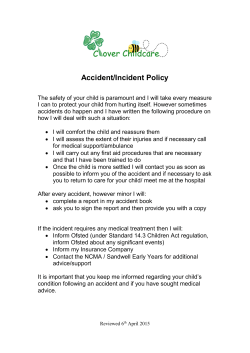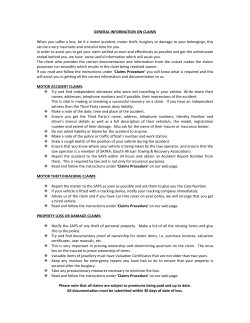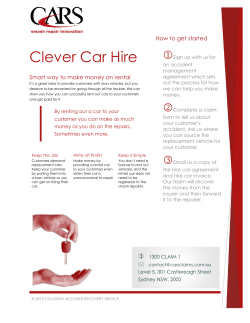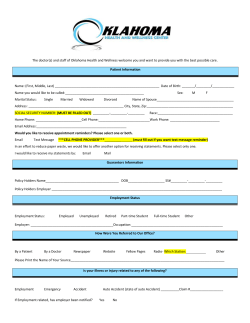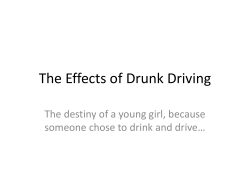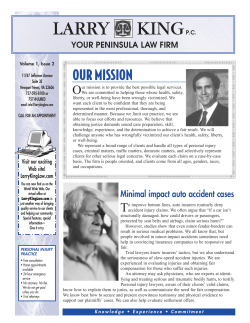
Exclusive of motorways, Glasgow contains about km
CYCLE ACCIDENT DISTRIBUTIONS IN THE CITY OF GLASGOW 1999-2013 COMMENTS AND RECOMMENDATIONS FOR GLASGOW CITY COUNCIL Bob Downie 19/05/15 http://mail.surfanytime.net/blogs/Glasgow CycleMan/ Exclusive of motorways, Glasgow contains about 1880km of potentially cycle-able roads, not that you would necessarily want to ride on all of them Data source http://www.openstreetmap.org/ In the 15 year period 1999 to 2013, approximately 1695 accidents within the City of Glasgow were reported to police in which a cyclist was involved. That can be expressed as 113 cycle accidents/year or 0.90 accidents/km of cycle-able road Blue dot =male casualty Red dot = female casualty Data source http://discover.ukdataservice.ac.uk/ The accident intensity for the period 1999-2015 can be displayed as a heatmap where the “hot” colours represent roads with high accident rates It is apparent that certain parts of the City Centre, parts of the Southside and much of the West End are areas with the highest cycle accident rates There are also isolated “bulls-eyes” with high accident rates HIGH ACCIDENT ROADS One can arbitrarily select a subset of Glasgow’s roads with the highest rates of cycle accidents (black lines) Selected roads total 16.3km and in the period 1999-2013 suffered approximately 288 accidents to which the police were called This works out at approximately 18 accidents/km of cycle-able road, 20x the Glasgow road average HIGH ACCIDENT ROADS 1999-2013 In the adjacent map the roads with the highest cycle accident rates have the accident points posted in colour (blue =male casualty, red = female casualty) On other roads, the accident points are shown as small black dots. Sections of the following roads are observed to have high accident rates. Argyle Street, Bath Street, Blythewood Square, Byres Road, Dumbarton Road, Eglington Street, Gibson Street, Gordon Street, Great Western Road, Highburgh Road, Kelvin Bridge, Kelvin Way, Kilmarnock Road, Pollokshaws Road, Sauchiehall Street, St Vincent Place, St Vincent Street, Stockwell Street, Trongate, University Avenue, Victoria Road,West George Stre et, West Regent Street Shieldhall Rd Roundabout 10 accidents Shieldhall Rd Roundabout 8 accidents Paisley Rd W. Roundabout 5 accidents Pollok Roundabout 6 accidents Govan 10 accidents Dumbarton Rd Roundabout 6 accidents Clyde Arc Br. Junction 7 accidents ACCIDENT HOTSPOTS & ROUNDABOUTS 1999-2013 In addition to the roads with higher accident rates, the accident distribution shows distinct hotspots. From the accident distribution patterns it is clear that all junctions have the potential to be dangerous, but some have had a lot more accidents than others, in particular major roundabouts. Shields Rd Roundabout 7 accidents In the adjacent map of the Southside, hotspots are indicated with the numbers of accidents given. The roundabouts on Barrhead Road and Shieldhall Road have particularly high accident rates Pollok Park Auldhouse Roundabout 12 accidents Battlefield Roundabout 5 accidents Other small hotspots are present (e.g. Govan, sections of Paisley Road West) but have no clear association with a single junction Commentary and Discussion • From the foregoing, one might take the message that Glasgow’s roads are dangerous for cycling. This is absolutely not the case. • While any accident is one too many, the average rate of 113 cycle accidents a year is low given the number of cyclists on the road: additionally, most accidents are minor. In the 15 year period of this survey, the number and severity of cycle accidents in the City of Glasgow were as follows • Slight cycle accidents -1415 • Serious cycle accidents- 253 • Fatal cycle accident -27 • The main thrust of this presentation has been to show that accident rates have a very high variability across the city, with parts of the West End City Centre and Southside having accident rates 20x higher than Glasgow’s roads on average • It is extremely important to stress that this does not mean that these roads are per se dangerous. More research will need to be conducted to determine the reason(s) for the higher rates, but it is known that, by and large, these roads have very high cycle traffic. This alone may explain the higher accident rates. However, as a further observation, many of the high accident roads are congested shopping streets with numerous junctions and on-street parking (e.g. Byres Road, Victoria Road). Few have any cycle-specific infrastructure. To what extent these factors influence the safety of cyclists needs to be evaluated • The roundabouts are more difficult to explain other than in the obvious way. Their presence as bulls eyes on the accident heatmaps points to these locations being egregiously dangerous, clearly much more so than their access roads Recommendations • The accident distribution data clearly show that major roundabouts are dangerous for cyclists. The high accident rates on the roundabouts is in profound contrast to the low accident rates on the access roads. As a matter of urgency the council should investigate ways of making roundabouts safer for cyclists. This may involve changing road layouts to slow vehicles as they enter the roundabouts, but serious consideration should be given to the installation of “Dutch-Style” roundabouts where cyclists have their own dedicated lane • The fact that a proportion of Glasgow’s roads have accident rates 20x the city’s average tells us we should prioritise making this small subset of Glasgow’s roads as safe as possible as soon as possible. Immediate reductions in speed limits to 20ph would help. Additionally, the council needs to consider the impacts of the amount of vehicular traffic, junctions and parked cars on cycling safety in these areas, with a view taking remedial action depending on the findings
© Copyright 2025
